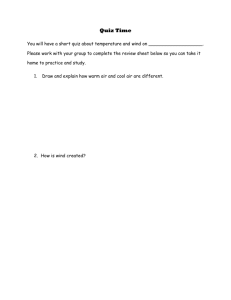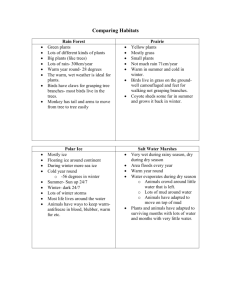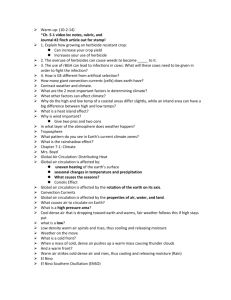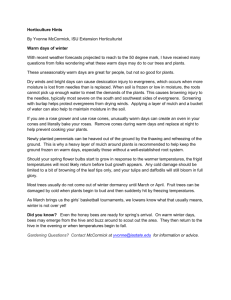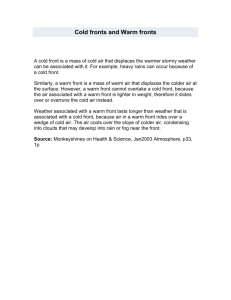warmwinter - Iowa State University
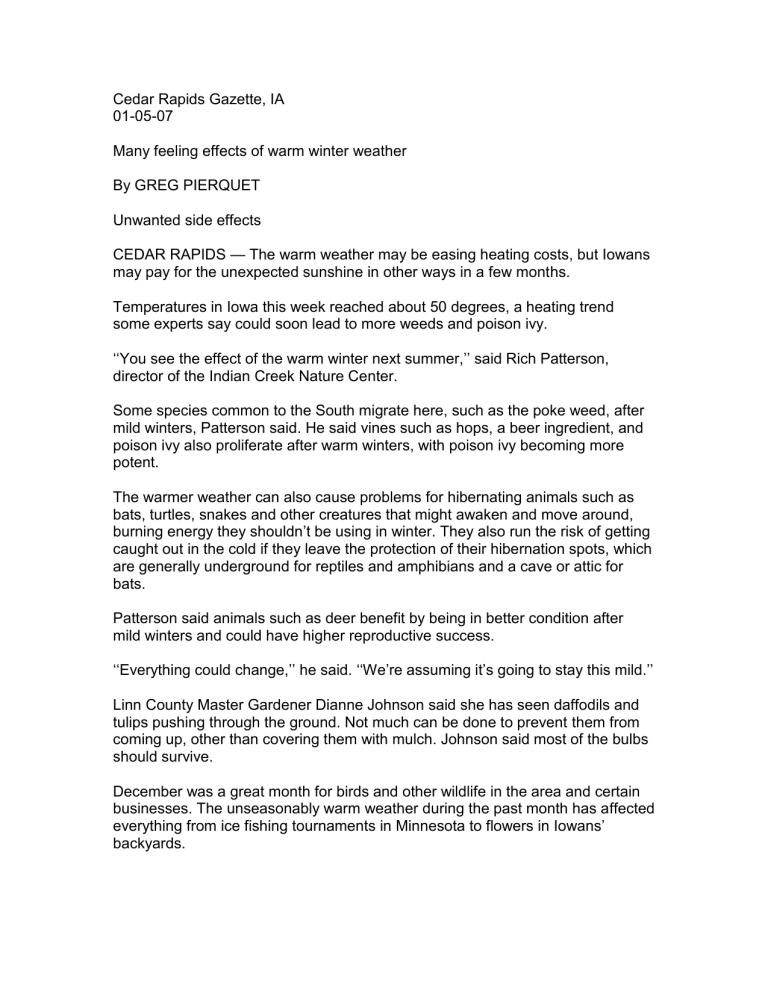
Cedar Rapids Gazette, IA
01-05-07
Many feeling effects of warm winter weather
By GREG PIERQUET
Unwanted side effects
CEDAR RAPIDS — The warm weather may be easing heating costs, but Iowans may pay for the unexpected sunshine in other ways in a few months.
Temperatures in Iowa this week reached about 50 degrees, a heating trend some experts say could soon lead to more weeds and poison ivy.
‘‘You see the effect of the warm winter next summer,’’ said Rich Patterson, director of the Indian Creek Nature Center.
Some species common to the South migrate here, such as the poke weed, after mild winters, Patterson said. He said vines such as hops, a beer ingredient, and poison ivy also proliferate after warm winters, with poison ivy becoming more potent.
The warmer weather can also cause problems for hibernating animals such as bats, turtles, snakes and other creatures that might awaken and move around, burning energy they shouldn’t be using in winter. They also run the risk of getting caught out in the cold if they leave the protection of their hibernation spots, which are generally underground for reptiles and amphibians and a cave or attic for bats.
Patterson said animals such as deer benefit by being in better condition after mild winters and could have higher reproductive success.
‘‘Everything could change,’’ he said. ‘‘We’re assuming it’s going to stay this mild.’’
Linn County Master Gardener Dianne Johnson said she has seen daffodils and tulips pushing through the ground. Not much can be done to prevent them from coming up, other than covering them with mulch. Johnson said most of the bulbs should survive.
December was a great month for birds and other wildlife in the area and certain businesses. The unseasonably warm weather during the past month has affected everything from ice fishing tournaments in Minnesota to flowers in Iowans’ backyards.
Mike Stegmann, director of the Marshall County Conservation Board, said he has noticed and has heard reports of flowers and robins showing up in backyards across the state and the country.
The movement patterns of birds like geese have been strange, as though the fall months are still here.
“Usually the geese are driven south because of deep snow or bitterly cold temperatures,” he said. “Right now, the geese around here are in fall mode — not spring yet, because the light dictates that — but they are acting more like it’s still fall.”
Despite the abundance of grass and bugs for Iowa’s small animals, Stegmann said vegetation might not fare as well if trends continue.
“People might be seeing crocuses and tulips popping up if we continue to get this warm rain,” Stegmann said. “Trees and plants flowering during winter will not really affect them, but it could cause the plants to abort reproduction for that year.”
But will this warm winter affect crops? Iowa State University Extension Crop
Specialist John Holmes said there are good and bad things about the warmer weather — though he has yet to see a major impact this soon in the season.
“In general [warmer weather] is good for the soil,” he said. “Whenever the ground isn’t frozen, it can absorb more water.”
He said it would be a good thing to receive more freezing in general to kill off a higher percentage of the beetles and other insects that do damage to crops, but felt at this point in the year, there has been little effect.
Holmes said the soil freezing and thawing also tends to break up compacted ground areas, which would be another benefit if the area experiences more cold weather before spring.
Local businesses and municipalities are feeling the effects as well.
Marshalltown Street Superintendent Bob Wall said the warm weather is saving the city money and resources — money allocated for snow removal it can carry over into the rest of the year.
He said an average, three-inch snow will result in approximately $4,000 in materials cost and $5,000 in wages to clear the streets.
John Schrempf, a golf professional at American Legion Golf Course in
Marshalltown, is just fine with the warm weather, too.
“We’re back open today,” he said. “This is the first time in my 14 years of working here that we’ve been open in January.”
He said the course saw 50 to 60 players last Friday and he expected to have another 10 to 20 Thursday afternoon.
Meteorologist Craig Cogil of the National Weather Service in Johnston, said recent warm weather is outside the norm.
“Certainly this would fit into patterns we see with El Nino winters,” he said.
“Typically, we’ll see the jet stream will allow Canadian air down into Iowa by this time of year, but this year the jet stream is staying in place, which keeps the cold air farther north.”
He said the average temperature in Marshalltown in December was 8.9 degrees warmer than average. Temperatures across the country have been as high as 20 degrees over the average for extended periods.
Cogil said changes in winter temperatures generally is where people notice a different weather pattern such as El Nino. The entire El Nino pattern, he said, can take anywhere from 3-7 years to run its course.
He said while area meteorologists are working on a study concerning El Nino weather patterns and severe weather, the data has not indicated any major differences thus far.
